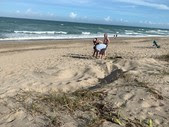Gulf Coast Adaptation and Resilience Plan Workshops
A new collaboration between FWC, the American Society of Adaptation Professionals and the Gulf of Mexico Alliance aims to build capacity for natural resource managers tasked with carrying out critical conservation work in a rapidly changing climate through a professional development course. Launching in summer 2020, this interactive, web-based course on adaptation and resilience is intended to equip conservation practitioners working in the Gulf Coast Region of the Southeastern United States with both knowledge of foundational adaptation concepts and skills to apply these concepts to their daily work.
Practitioners from all sectors and at all stages of career are welcome and encouraged to participate. Limited spots are available, and enrollment will officially begin in early April. Anyone interested in taking this course should email Lily Becker (Lily.Becker@myFWC.com) to be placed on the contact list. This course will be free of cost and sessions will run from June through September 2020.
New on MyFWC.com/Research | Social Media Corner
YouTube:
As part of an ongoing investigation, the FWC and our partners are caring for two kittens of an affected female panther that was euthanized due to the severity of her condition. 
Flickr:
With degrees ranging from Animal Behavior to Zoology, the Fish and Wildlife Research Institute recognizes its Women in Science. 
Facebook:
The first leatherback nest of 2020 was observed and photographed by citizen on south Hutchinson Island in Martin County. |
Instagram Favorite

Tracey Cauthen recently reported stumbling upon a ~4 ft Rainbow Snake (Farancia erytrogramma), while hiking in the Ocala National Forest. The Florida Museum confirms this is the first record of this species in Marion County since 1969! FWRI biologists speculate the recent drawdown of Rodman Reservoir had this rainbow snake on the move.
Rainbow snakes are highly-aquatic, spending most of their life hidden amongst aquatic vegetation; seldom seen, even by herpetologists, due to their cryptic habits. Burrowing near creeks, lakes, marshes, and tidal mudflats, rainbow snakes specialize in eating eels, earning the nickname “eel moccasin”.
Rainbow snakes are highly-aquatic, spending most of their life hidden amongst aquatic vegetation; seldom seen, even by herpetologists, due to their cryptic habits. Burrowing near creeks, lakes, marshes, and tidal mudflats, rainbow snakes specialize in eating eels, earning the nickname “eel moccasin”.
Our Mission
Through effective research and technical knowledge, we provide timely information and guidance
to protect, conserve, and manage Florida's fish and wildlife resources.
to protect, conserve, and manage Florida's fish and wildlife resources.
http://live.oysterradio.com/

No comments:
Post a Comment